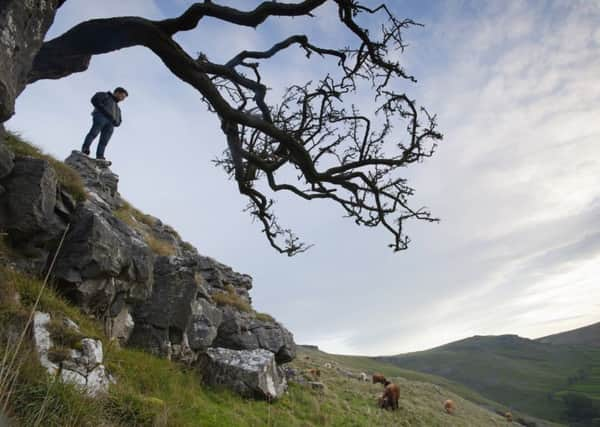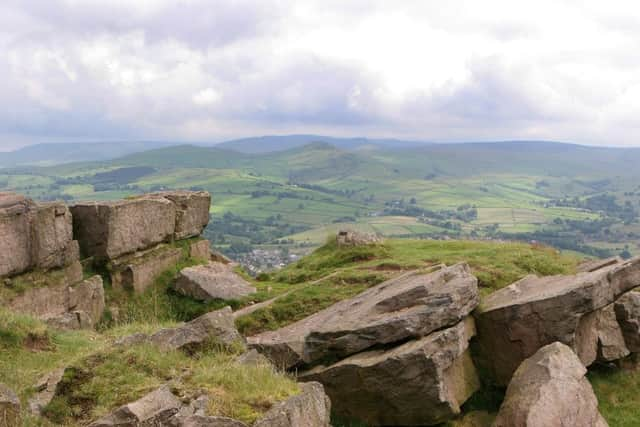Walking back to happiness on the Pennine Way


Fifty years after it opened, there remains a special aura about the 270-mile route that winds its way from the Peak District to the Scottish Borders. Perhaps the titanic struggle to create Britain’s first long-distance path has something to do with the hold that the Pennine Way has. Though it opened in 1965, the seeds were sown in 1932 with the mass trespass onto Kinder Scout, which forms part of the path, when ramblers demanded the “right to roam”.
Coupled with that, in 1935 journalist and ramblers’ champion Tom Stephenson wrote an article in the Daily Herald headlined “Wanted: A Long Green Trail”, suggesting something akin to the Appalachian Trail in America, but from the Peak District to the Cheviots.
Advertisement
Hide AdAdvertisement
Hide AdIt took three further decades before the route became a reality after enormous struggles with landowners over access. The official opening took place at Malham in April 1965.


While other long-distance routes offer different scales of difficulty, the Pennine Way is still regarded as the supreme challenge given that you climb the equivalent of Everest plus an additional 8,000ft on top of that.
That impressive statistic underlines the level of fitness required to tackle the Pennine Way – it is no gentle stroll in the park as it traverses some of the most beautiful yet inhospitable parts of the country.
It is therefore essential to be properly equipped and also possess navigational skills as in the mid-summer it can be treacherous as I discovered this year when the weather was at times appalling.
Advertisement
Hide AdAdvertisement
Hide AdIt was the special anniversary of the Pennine Way that lured me back 35 years after I had last completed the path. In fact, I had completed two thirds of the walk in 1979 when injury curtailed my trip at Alston, the highest market town in England, after two thirds of the route.
Rather than resume where I left off, I did the whole thing from Edale in Derbyshire to Kirk Yetholm, just across the Scottish border, 12 months later. Back then the Pennine Way was very much in its infancy and today many of the peat paths have been replaced by umpteen miles of stone slabs. It means you can cross the likes of Bleaklow, Featherbed Moss and Black Hill at a relative canter at three miles an hour whereas in years gone by it was an almighty slog through the bog.
The stone flagged paths have other benefits. They have prevented erosion that had become a major concern. I remember in 1980 Black Hill being a massive expanse of bog that resembled treacle. The paths also mean it is a doddle navigating these stretches that previously required a map and compass.
There are, however, some sections that still require navigational skills and vigilance – I am referring to Knock Fell in Cumbria which was enveloped in mist reducing visibility to a matter of yards. The path disappeared and a compass bearing was required to find the path to Great Dun Fell.
Advertisement
Hide AdAdvertisement
Hide AdIt was also somewhat surreal to get from Edale to Hadrian’s Wall without once sinking above my boots. In the latter stages, though, there were stretches that remained untouched and were a reminder of what all the path was like in years gone by.
The route itself offers a diverse variety of landscapes from the bleak but beautiful stretches of moorland to the glorious Dales, picturesque route along the River Tees, a history lesson along the best preserved section of Hadrian’s Wall to the final stint over the wild and windswept Cheviots.
Apart from the walk, it is the people you meet and places you stay that also form an integral part of the Pennine Way experience. There are people I met 35 years ago that I am still friends with, an enduring bond that surely cannot be found elsewhere. Among them are Dutchmen Gerard de Waal and Nico Pot who I only met fleetingly on the first night of my 1980 journey at Crowdon Youth Hostel which sadly no longer exists.
We had completed the Edale to Crowdon stage in a deluge and the pair were forced to stay an extra day to dry their gear while I continued. It was not until the next year that I received a surprise letter from Gerard who had returned the following year with wife Helga to take her on a Pennine Way journey by road. He had found my contact details in the register of walkers who have completed the trek, which can be found at the Border Hotel in Kirk Yetholm, journey’s end.
Advertisement
Hide AdAdvertisement
Hide AdGerard developed a burning passion for the Pennine Way, returning most years, and he even tracked down Tom Stephenson, who was in his late eighties, and took him by car back to his favourite haunts.
On one of his trips Gerard also met musician Mike Harding who was walking the Pennine Way for a radio documentary and they, too, became friends. Mike was later to become president of the Ramblers’ Association.
Some years later Gerard, who even wrote a book Going Dutch The Pennine Way, arranged a reunion at The Buck Inn, Malham, a magical night attended by Tom, Mike and many other friends he had made, myself included.
One of my most enduring memories from 1979 and 1980 were my stays at Woodhead Farm, Lothersdale, home of Leonard and Ethel Burnop. It was a working farm and Ethel, an elderly wizened lady, would never turn any walker away even if the house was already full. Visitors were shoe-horned in so I found myself sharing a double bed with a stranger, while someone else slept on the floor nearby. Ethel would stay up long into the night washing walkers’ clothes and it was no wonder she had become a legendary figure. That summed up the spirit of the Pennine Way.
Advertisement
Hide AdAdvertisement
Hide AdSadly Woodhead Farm is no longer a refuge for walkers or indeed a working farm. The buildings have been converted into homes, but while the Burnops may no longer be mainstays of the Pennine Way, others have stepped into their shoes.
And none more so than Colin and Joyce Taylor because without them Pennine Way walkers would be well and truly stumped. The closure of Byrness Youth Hostel in Northumberland left a chronic shortage of accommodation for walkers before the final leg.
The couple stepped in and spent £250,000 transforming the youth hostel into the Forest View Inn which is an inviting guest house with the hosts providing an amazing service for walkers.
From the minute you walk through the door and Colin takes your boots, brushes them, fills them with paper and puts them in an outbuilding that doubles up as a drying room, to the home-prepared meals Joyce prepares, it is a stay to remember.
Advertisement
Hide AdAdvertisement
Hide AdAnd for those not wishing to do the final 28-mile leg in one stint – it took me just under 13 hours in the most inhospitable weather – the couple arrange a pick-up service so it can be split over two days.
Equally devoted and caring was the warden at Alston Youth Hostel which had been closed temporarily due to heavy rain flooding the building, causing a shortage of accommodation in the market town made worse because of a wedding with guests seeking somewhere to stay.
Fortunately I found a bed and breakfast to stay on the edge of town but the concerned warden rang back to see if I had been fixed up and, had I not, offered to drive me nine miles to another youth hostel.
It is this kind of warmth and kindness that restores your faith in humanity in this troubled world in which we live.